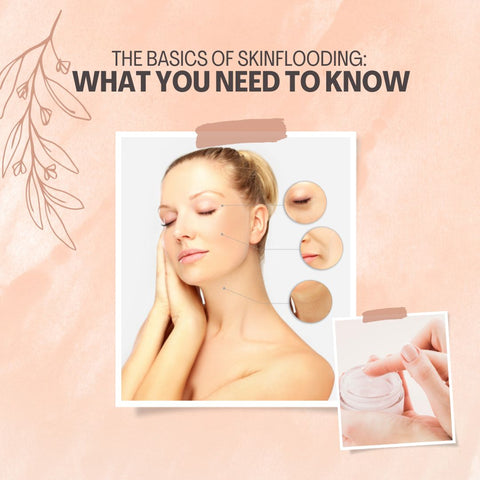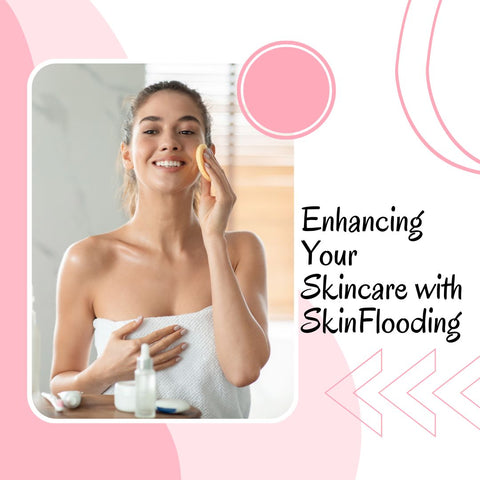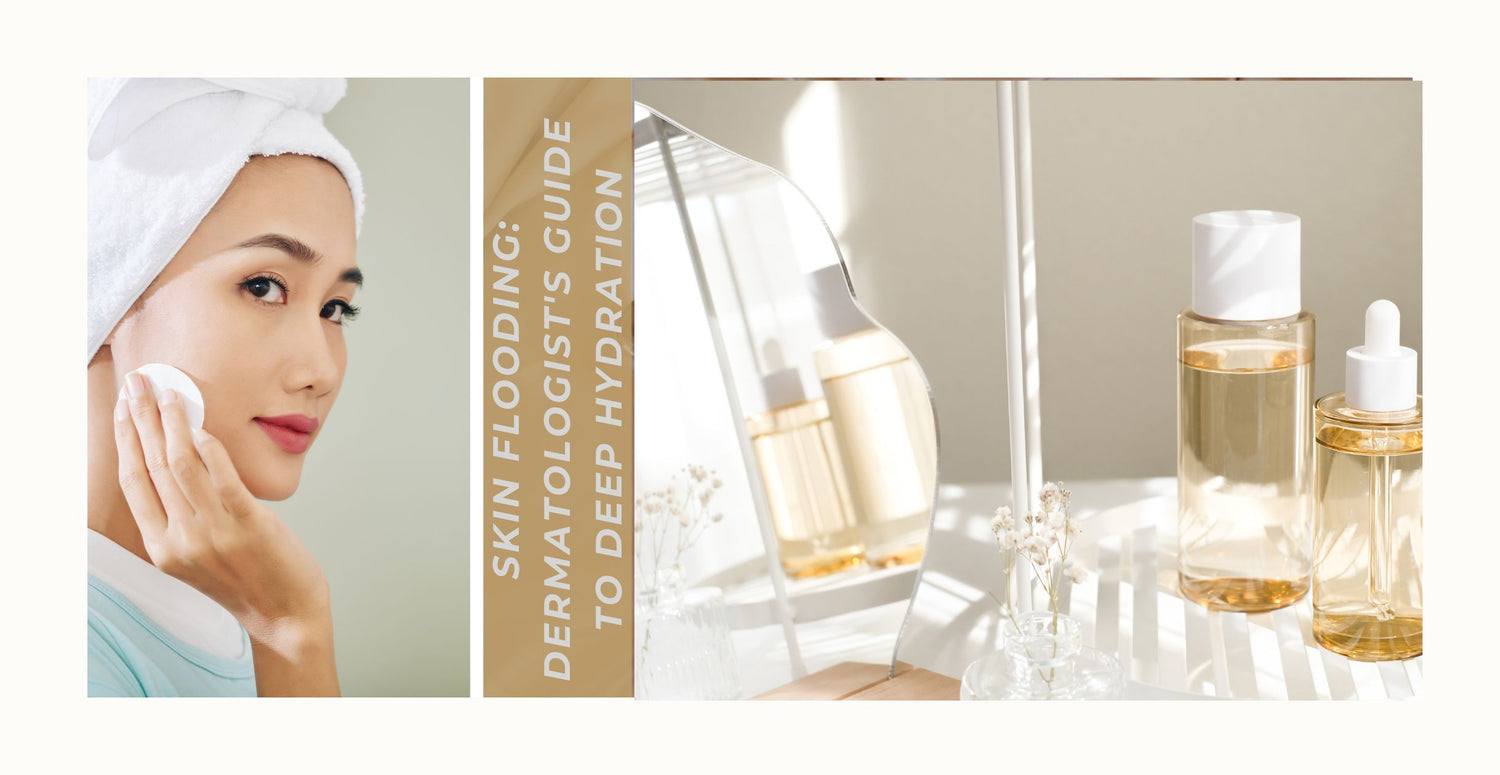Taking care of acne-prone skin throughout the winter while on tretinoin therapy requires extra caution to avoid excessive dryness, inflammation, and sensitivity. This blog provides a personalised approach to winter care for acne-prone skin that includes tretinoin.
The Basics of #SkinFlooding: What You Need to Know

#SkinFlooding is a skincare technique that involves soaking the skin in lightweight, hydrating products to promote hydration, plumpness, and a glowing complexion. Here is everything you need to know about #SkinFlooding:
-
#SkinFlooding focuses on intense hydration of the skin. Hydration is essential for maintaining skin health, increasing elasticity, and avoiding dryness and irritation.
-
#SkinFlooding entails applying multiple lightweight, hydrating products to the skin to create a "flood" of moisture. This can include essences, serums, ampoules, and light moisturizers.
-
Begin with the lightest consistency products and work your way up to thicker ones. This enables each product to penetrate the skin effectively and provide maximum hydration.
-
Instead of rubbing or massaging the products into the skin, gently pat and press them in with your fingertips. This allows the products to absorb more effectively while avoiding unnecessary friction, which can irritate the skin.
-
#SkinFlooding can be tailored to your skin's specific requirements. You can vary the number and type of products you use depending on your skin type, concerns, and climate.
-
#SkinFlooding can be done on a daily or as-needed basis, depending on your skin's hydration and response to the technique. Some people prefer to #SkinFlood in the morning or evening, while others may do so both in the morning and at night.
-
The advantages of #SkinFlooding include increased hydration, plumpness, and a dewy, radiant complexion. It can also improve the effectiveness of subsequent skincare products, such as serums, moisturisers, and treatments.
-
#SkinFlooding works for all skin types, including dry, oily, combination, and sensitive skin. Those with oily or acne-prone skin may prefer to use lightweight, non-comedogenic products to avoid clogging pores.
Understanding the Concept of #SkinFlooding
#SkinFlooding is a skincare trend that focuses on deeply hydrating the skin by layering lightweight, water-based products. The concept is to saturate the skin with hydrating ingredients to increase moisture, plumpness, and promote a healthy, radiant complexion. This blog breaks down the key aspects of #SkinFlooding, including hydration, layering lightweight products, application order, gentle application technique, customisation, frequency, and benefits.
The Science Behind Effective Skin Hydration
Effective skin hydration is essential for preserving skin health, elasticity, and youthfulness. The science of effective skin hydration entails understanding the skin's barrier function, natural moisturising factors, and the role of specific skincare ingredients. Here is a breakdown of the main elements:
-
Skin Barrier Function: The stratum corneum, the skin's outermost layer, acts as a barrier, preventing water loss and protecting against environmental stress. A healthy skin barrier is essential for retaining moisture and keeping skin hydrated. Damage to the skin barrier can cause dehydration, dryness, and increased sensitivity.
-
Natural Moisturising Factors (NMF): NMF are substances found in the skin that help it stay hydrated by attracting and retaining water. These include amino acids, urea, ceramides, hyaluronic acid, and glycerin. NMF play an important role in regulating skin hydration and maintaining skin barrier function.
-
Humectants: These substances draw in water from the surrounding air and cling to the skin, promoting a more hydrated state. In skincare products, humectants like urea, glycerin, sorbitol, and hyaluronic acid are frequently used. These components suck moisture into the skin, giving it a plumper, more moisturised appearance.
-
Emollients: Emollients are lipid-based substances that work by bridging the spaces between skin cells to help smooth and soften the skin's surface. They establish a barrier of defence that keeps moisture in and stops water loss. Emollients include things like fatty acids, plant oils, ceramides, and squalane.
-
Occlusives: To retain moisture and stop it from evaporating, occlusive ingredients create a barrier on the skin's surface. They shield the skin from outside allergens and aid in locking in moisture. Petroleum-based materials, mineral oil, beeswax, and silicone derivatives are frequently used as occlusive ingredients.
-
Ceramides: The skin's natural barrier contains ceramides, which are vital lipids that support the barrier's integrity and stop moisture loss. Ceramide-containing skincare products can improve overall skin health, improve hydration, and replenish the skin's lipid barrier.
-
Water Content: Drinking plenty of water is essential for overall hydration, but it is also important to hydrate the skin topically. Applying water-based skincare products replenishes moisture levels and supports the skin's natural hydration processes.
-
Environmental Factors: Dry air, cold weather, wind, and UV radiation can all compromise the skin's barrier function, resulting in dehydration. Using skincare products containing hydrating and protective ingredients can help reduce the effects of environmental stressors on the skin.
Key Ingredients for Successful #SkinFlooding
#SkinFlooding entails saturating the skin with lightweight, hydrating ingredients to increase moisture levels and promote a healthy, radiant appearance. Here are some common ingredients used in #SkinFlooding:
-
Hyaluronic Acid: Hyaluronic acid is a potent humectant that attracts and retains up to 1000 times its weight in water, making it an ideal hydrating ingredient for #SkinFlood. It plumps up the skin, reduces the appearance of fine lines and wrinkles, and increases overall hydration.
-
Glycerin: Glycerin is a natural humectant that draws moisture from the environment into the skin, hydrating and softening it. It is lightweight, non-greasy, and gentle on all skin types, making it a popular choice for #SkinFlooding.
-
Ceramides: Lipid molecules called ceramides to aid in preserving the skin's moisture-retaining barrier and preventing moisture loss. Including ceramides in #SkinFlooding helps strengthen the skin's protective barrier, improve hydration, and enhance overall skin health.
-
Niacinamide: Niacinamide, also known as vitamin B3, is a versatile skincare ingredient that provides hydration, brightness, and skin barrier strength. It improves skin texture, reduces redness, and increases moisture levels, making it a great addition to your #SkinFlooding routine.
-
Panthenol (Provitamin B5): Panthenol is a soothing and hydrating ingredient that replenishes and retains moisture in the skin. It has anti-inflammatory properties and promotes skin healing, making it ideal for #SkinFlooding, particularly on sensitive or irritated skin.
-
Aloe Vera: This natural ingredient is well-known for its anti-inflammatory, hydrating, and calming qualities. It hydrates and calms the skin, reduces redness and irritation, and promotes overall skin health in #SkinFlooding routines.
-
Sodium PCA: Sodium PCA is a natural humectant found in the skin's NMF that attracts and holds moisture. Including sodium PCA in #SkinFlooding replenishes hydration levels, improves skin elasticity, and promotes a smooth, supple complexion.
-
Plant Extracts: Many plant extracts, including green tea extract, chamomile extract, and calendula extract, have hydrating and soothing properties that aid in #SkinFlooding routines. They hydrate, calm, and nourish the skin, adding antioxidant protection and promoting overall skin health.
-
Alpha Hydroxy Acids (AHAs): AHAs, such as glycolic acid and lactic acid, can help with #SkinFlooding by exfoliating and brightening the skin. However, they should be used with caution and avoid excessive exfoliation, especially when combined with other hydrating ingredients.
Implementing #SkinFlooding in Your Skincare Routine

Implementing #SkinFlooding into your skincare routine involves incorporating hydrating products and layering them strategically to maximize moisture levels in the skin. Here's how to integrate #SkinFlooding effectively:
-
Begin by cleansing your face with a gentle, hydrating cleanser to remove any impurities and prepare your skin to absorb moisture.
-
If you choose to exfoliate, do so before #SkinFlooding to remove dead skin cells and allow better absorption of hydrating ingredients. Opt for a gentle exfoliant suitable for your skin type, such as a mild chemical exfoliant or a gentle scrub.
-
Layer lightweight, water-based products onto your skin, starting with the thinnest consistency and gradually moving to thicker textures. This can include essences, serums, ampoules, and lightweight moisturizers. Apply each product evenly across your face, neck, and décolletage.
-
Look for products containing key hydrating ingredients such as hyaluronic acid, glycerin, ceramides, niacinamide, and panthenol. These ingredients attract and retain moisture, strengthen the skin barrier, and promote overall skin health.
-
Instead of rubbing or massaging the products into your skin, gently pat and press them in using your fingertips. This helps the products absorb more effectively and minimizes friction, which can irritate the skin.
-
Tailor your #SkinFlooding routine to suit your skin's specific needs and concerns. You can adjust the number and type of products used based on your skin type, climate, and personal preferences.
-
Keep your skin hydrated throughout the day by spritzing with a hydrating facial mist or reapplying lightweight moisturizer as needed. This helps maintain moisture levels and keeps your skin feeling refreshed.
-
Finish your #SkinFlooding routine with a broad-spectrum sunscreen during the day to protect your skin from UV damage. Even on cloudy days, UV rays can penetrate the skin and cause damage, so sunscreen is essential for maintaining skin health.
-
Incorporate #SkinFlooding into your skincare routine consistently to see the best results. Hydration works cumulatively, so the more you hydrate your skin, the better it will look and feel over time.
-
Pay attention to how your skin reacts to #SkinFlooding and adjust your routine accordingly. If you experience irritation or sensitivity, reduce the number of products you use or switch to more gentle formulations.
By following these steps and tailoring your #SkinFlooding routine to your skin's requirements, you can effectively increase hydration, improve skin texture, and achieve a radiant, healthy complexion.
Step-by-Step Guide to #SkinFlooding
Here's a step-by-step guide for incorporating #SkinFlooding into your skincare routine.
-
Cleanse Your Skin: Begin by cleansing your face with a gentle, hydrating cleanser that removes dirt, oil, and impurities without removing your skin's protective moisture barrier. Dry your skin with a clean towel.
-
Exfoliate (Optional): If you choose to exfoliate before #SkinFlooding, do so to remove dead skin cells and improve hydrating ingredient absorption. Choose a gentle exfoliant that is appropriate for your skin type, such as a chemical exfoliant or a mild scrub.
-
Prep Your Skin: Use a toner or essence to hydrate and prepare your skin for #SkinFlood. Look for products that include hydrating ingredients like hyaluronic acid or glycerin to add moisture.
-
Layer Lightweight Products: Start #SkinFlooding by applying light, water-based products to your skin. Begin with the thinnest consistency and gradually increase to thicker textures. This can include serums, ampoules, and light moisturisers.
-
Choose Hydrating Ingredients: Look for products that include key hydrating ingredients like hyaluronic acid, glycerin, ceramides, and niacinamide. These ingredients attract and retain moisture, strengthen the skin's barrier, and improve overall skin health.
-
Apply Products Evenly: Spread each product evenly over your face, neck, and décolletage, avoiding the sensitive eye area. Instead of rubbing or massaging the products into your skin, gently pat and press them in with your fingertips.
-
Hydrate Throughout the Day: Keep your skin hydrated by spritzing it with a hydrating facial mist or reapplying a lightweight moisturiser as needed. This helps to maintain moisture levels and leaves your skin feeling refreshed.
-
Sun Protection: After your #SkinFlooding routine, apply a broad-spectrum sunscreen during the day to protect your skin from UV damage. Sunscreen should be applied generously to all exposed skin areas, including the face, neck, and hands.
-
Monitor Your Skin: Keep track of how your skin reacts to #SkinFlooding and adjust your routine as necessary. If you experience irritation or sensitivity, reduce the number of products you use or switch to more gentle formulations.
-
Consistency is Key: To achieve the best results, regularly incorporate #SkinFlooding into your skincare routine. Hydration works cumulatively, so the more you hydrate your skin, the better it will look and feel over time.
By following this step-by-step guide, you can easily incorporate #SkinFlooding into your skincare routine to increase hydration, improve skin texture, and achieve a radiant, healthy complexion.
Tailoring #SkinFlooding to Your Skin Type
Tailoring #SkinFlooding to your specific skin type entails selecting products and modifying your routine to address your skin's unique needs and concerns. Here's how to tailor #SkinFlooding to different skin types:
-
Dry Skin: Choose hydrating products with rich textures, such as creamy serums or moisturisers, to deeply nourish and hydrate your skin. Look for ingredients like hyaluronic acid, ceramides, and oils that will replenish moisture and strengthen the skin barrier. Consider finishing with an occlusive product, such as a facial oil or balm, to seal in moisture and prevent water loss.
-
Oily Skin: Choose lightweight, non-comedogenic products that provide hydration without feeling greasy or clogging pores. Look for oil-free serums and gel moisturisers that include hydrating ingredients such as hyaluronic acid and glycerin. Consider using products containing niacinamide or salicylic acid to help regulate oil production and reduce the appearance of pores.
-
Combination Skin: Use a combination of light hydrating products for oily skin and richer formulations for dry skin. Balance the skin by using lighter textures on the T-zone and more emollient products on drier areas such as the cheeks. Consider using specific treatments, such as spot treatments for acne-prone areas or hydrating masks for dry patches.
-
Sensitive Skin: To reduce the risk of irritation, use gentle, fragrance-free products that contain soothing ingredients. Look for products with few ingredients and avoid irritants such as alcohol, fragrances, and essential oils. Consider patch-testing new products before using them on your entire face to ensure they do not cause irritation or allergies.
-
Acne-Prone Skin: Choose lightweight, noncomedogenic products that will not clog pores or worsen acne. Look for hydrating ingredients such as hyaluronic acid, glycerin, and ceramides that will not cause breakouts. Consider incorporating targeted treatments, such as benzoyl peroxide or salicylic acid, to combat acne while keeping skin hydrated.
-
Mature Skin: Choose anti-aging products containing hydrating ingredients such as hyaluronic acid, peptides, and antioxidants to plump up the skin and reduce the appearance of fine lines and wrinkles. Look for products designed specifically for mature skin, such as moisturisers that include firming or lifting ingredients. Consider applying a hydrating facial oil or serum as a pre-moisturizer step to provide additional hydration and nourishment.
Combining Products for Optimal Hydration
Combining products strategically can improve hydration and promote healthy, glowing skin. Here's how to layer products effectively for maximum hydration:
-
Begin with a Clean Canvas: Cleanse your skin thoroughly to remove impurities and prepare it to absorb moisture more efficiently.
-
Hydrating Toner or Essence: Use a hydrating toner or essence to replenish moisture and prepare the skin for future products. Look for formulas that include hydrating ingredients such as hyaluronic acid, glycerin, and botanical extracts.
-
Lightweight Serum: Apply a lightweight serum with hydrating ingredients to your skin. Serums containing hyaluronic acid, niacinamide, or vitamin B5 can help with hydration and skin texture.
-
Thicker Serum or Ampoule: Use a thicker serum or ampoule to provide extra hydration and nourishment to the skin. Choose formulas that contain ceramides, peptides, or botanical oils to strengthen the skin barrier and keep moisture in.
-
Facial Oil (Optional): If your skin is extremely dry or dehydrated, consider using a facial oil as the next step to seal in moisture and prevent water loss. Look for lightweight oils, such as squalane, jojoba oil, or rosehip oil, that will not feel heavy or greasy on the skin.
-
Moisturizer: Use a moisturizer to seal in all layers of hydration and create a protective barrier against environmental stressors. Choose a moisturizer based on your skin type, whether it is a lightweight gel for oily skin or a rich cream for dry skin.
-
Eye Cream: Do not forget to moisturise the delicate skin around your eyes with an eye cream. Look for formulas with hydrating ingredients like hyaluronic acid, peptides, or ceramides to plump up fine lines and reduce puffiness.
-
Sunscreen (Daytime): After your skincare routine, apply a broad-spectrum sunscreen to protect your skin from UV damage. Choose a lightweight, non-comedogenic formula with SPF 30 or higher to protect your skin without clogging pores.
-
Hydrating Mist (Optional): Throughout the day, use a hydrating mist to replenish moisture and revitalise your complexion. Keep a bottle handy for quick hydration when your skin feels dry or tight.
By combining these products in the proper order, you can create a complete skincare routine that maximises hydration and promotes healthy, glowing skin. Adjust the products and steps based on your skin type and concerns for customised hydration that meets your needs.
Enhancing Your Skincare with #SkinFlooding

Improving your skincare routine with #SkinFlooding entails using hydrating products and techniques to increase moisture levels and promote healthy, radiant skin. Here's how to maximise the benefits of #SkinFlooding:
-
Prep Your Skin: Begin with a clean canvas by cleansing your face with a gentle, hydrating cleanser to remove impurities and prepare your skin for maximum moisture absorption.
-
Use Hydrating Products: Select lightweight, water-based products that contain hydrating ingredients such as hyaluronic acid, glycerin, and ceramides. Look for serums, essences, and ampoules that are specifically designed to replenish moisture and improve skin hydration.
-
Layer Products Strategically: Layer your hydrating products from thinnest to thickest consistency for maximum absorption and efficiency. Begin with toners or essences, then go on to lightweight serums before finishing with heavier moisturisers or face oils.
-
Pat and Press: Rather than rubbing or massaging the products into your skin, gently pat and press them in with your fingertips. This allows the products to penetrate deeper into the skin and promotes better absorption of hydration.
-
Targeted Treatments: Add targeted treatments to your #SkinFlooding routine to address specific skin issues like acne, hyperpigmentation, and ageing. Look for products that contain active ingredients such as retinol, vitamin C, or niacinamide to improve the overall effectiveness of your skincare routine.
-
Hydrate Throughout the Day: Keep your skin hydrated by spritzing it with a hydrating facial mist or reapplying a lightweight moisturiser as needed. This helps maintain moisture levels and leaves your skin feeling refreshed and nourished.
-
Protect Your Skin: At the end of your skincare routine, apply a broad-spectrum sunscreen to protect your skin from UV rays and environmental stresses. Sunscreen is essential for keeping your skin healthy and preventing premature ageing.
-
Consistency is Key: To achieve the best effects, incorporate #SkinFlooding into your daily skincare routine consistently. Hydration works cumulatively, so the more you hydrate your skin, the better it will appear and feel over time.
By including #SkinFlooding in your skincare routine, you can effectively increase hydration, improve skin texture, and achieve a radiant, healthy complexion. Experiment with various products and techniques to determine which combination works best for your skin type and concerns.
The Benefits of Layered Hydration
Layered hydration has several skin benefits, including increased moisture levels, improved skin health, and a more even complexion. Here are some of the major advantages of layered hydration:
-
Deep Moisture Penetration: By layering hydrating products, each layer penetrates deeply into the skin, delivering moisture where it is most needed. This hydrates multiple layers of the skin, including the epidermis and dermis, providing long-lasting hydration.
-
Increased Hydration Levels: Applying multiple layers of hydrating products can significantly increase your skin's moisture levels. This helps to plump up the skin, smooth out fine lines and wrinkles, and create a more youthful appearance.
-
Enhanced Skin Barrier Function: Layered hydration strengthens the skin's natural barrier function, which is critical for moisture retention and environmental protection. A strong skin barrier helps to prevent water loss and maintain optimal hydration.
-
Improved Skin Texture: Hydrated skin is smoother, softer, and more evenly toned. Layering hydrating products can help improve skin texture by supplying vital moisture and nutrients to skin cells, promoting cell turnover, and boosting skin renewal.
-
Reduced Sensitivity and Irritation: Proper hydration soothes and calms the skin, lowering sensitivity and irritation. Layered hydration can help relieve dryness, redness, and inflammation, leaving the skin looking and feeling more comfortable and balanced.
-
Enhanced Product Absorption: Layering hydrating products before applying other skincare products creates a hydrated base, making subsequent products more absorbent. This increases the efficacy of active ingredients and ensures the best results from your skincare routine.
-
Youthful Radiance: Well-hydrated skin exudes a natural glow and radiance. Layered hydration helps to restore the skin's moisture balance, resulting in a healthy, luminous complexion that appears youthful and fresh.
-
Customisable Skincare: Layered hydration allows you to tailor your skincare routine to your skin's unique needs and concerns. You can vary the number and type of hydrating products you use depending on your skin type, climate, and seasonal changes.
Addressing Common #SkinFlooding Concerns
Addressing common concerns about #SkinFlooding requires understanding potential issues and implementing mitigation strategies. Here are some common concerns and how to handle them:
-
If your skin feels greasy or heavy after #SkinFlooding, you may be using too rich or occlusive products for your skin type. To avoid overly moisturising your skin, try using lighter, gel-based hydrating products or adjusting the number of layers.
-
Some people may experience clogged pores or breakouts after using #SkinFlooding, especially if they have oily or acne-prone skin. To avoid this, use non-comedogenic products and avoid layering excessively heavy or occlusive products. Incorporating acne-specific treatments, such as salicylic acid or benzoyl peroxide, can also help prevent breakouts.
-
If #SkinFlooding causes skin sensitivity or irritation, you may be using irritant-containing products or applying them too frequently. Switch to gentle, fragrance-free products designed for sensitive skin, and reduce the frequency of #SkinFlooding to allow your skin to heal.
-
Product pilling or balling up can happen when incompatible products are layered together or too much product is applied at once. To avoid this, let each layer fully absorb into the skin before applying the next, and avoid combining products with different textures that may not layer well together.
-
If #SkinFlooding causes your skin to feel dry or flaky, you may need to use more emollient or occlusive products to lock in moisture. Consider finishing with a facial oil or a thicker moisturiser to add extra hydration and prevent water loss.
-
Uneven product absorption can occur if products are not applied evenly or if some parts of the skin are more hydrated than others. To ensure even absorption, spread products evenly across your face, neck, and décolletage, then gently pat and press them into the skin to improve penetration.
-
While a dewy complexion is desirable, some people may find that #SkinFlooding makes their skin appear too shiny or greasy. If this is the case, blot excess oil with a tissue or apply a mattifying primer or powder to reduce shine and achieve a more even finish.
You can get the benefits of hydrated, radiant skin without having to deal with unpleasant side effects by addressing these common concerns and modifying your #SkinFlooding routine accordingly. Experiment with various products and techniques to determine what works best for your skin type and concerns.
Expert Tips for Maintaining Hydrated, Healthy Skin
Maintaining moisturised, healthy skin necessitates a combination of skincare techniques, lifestyle choices, and environmental factors. Expert tips for achieving and maintaining optimal skin hydration and health include staying hydrated, following a consistent skincare routine, selecting the right products, layering hydration, protecting your skin barrier, humidifying indoor air, eating a balanced diet, getting enough sleep, managing stress, and protecting against environmental damage. By incorporating these professional suggestions into your daily regimen, you can keep your skin hydrated and healthy, looking and feeling great. Consistency, patience, and a comprehensive approach to skincare and lifestyle behaviours are essential for maintaining long-term skin health and vibrancy.















